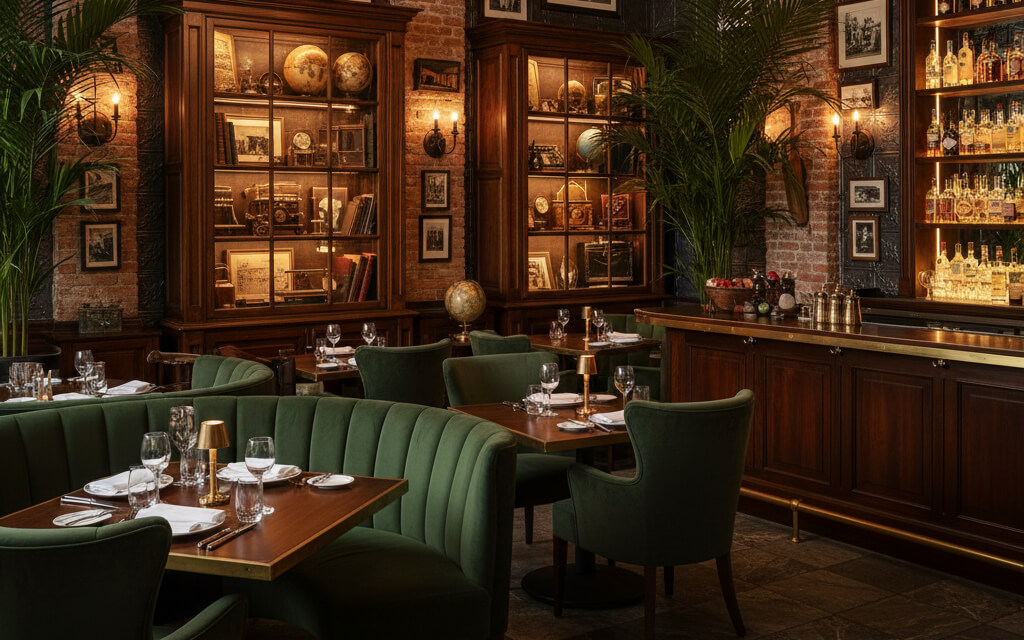October 10, 2025

Every great restaurant tells a story. It’s not just about the food — it’s about the experience. The design, ambiance, and atmosphere all contribute to telling a narrative that draws guests in, engaging them on a deeper level. A thoughtfully designed interior acts as an immersive storytelling device, guiding your diners through a journey of emotion, culture, and identity. When customers feel connected to the story behind your space, they don’t just visit once — they return, again and again.
The design of your restaurant is like an unfolding story, with each element contributing to the overall narrative. From the entrance decor to the table arrangements, every detail gives guests a glimpse into the essence of your brand. Whether you draw inspiration from local culture, family traditions, or global cuisines, your restaurant’s design should act as a physical manifestation of that story.
For example, a restaurant that features local art and handmade furniture might reflect a commitment to supporting the community, while a space inspired by a family recipe passed down through generations might use vintage photos or heirlooms to showcase its history.
Every design choice should speak to the story you want to tell. The texture of the walls, the lighting choices, and even the materials used in furniture can all reveal subtle aspects of your brand's personality and ethos.
Learn more about how storytelling can drive engagement in How to Turn Website Visitors into Paying Diners.
The world’s most admired restaurant interiors aren’t just spaces to eat — they’re immersive experiences that tell a clear, compelling story. Take, for example, a coastal-themed restaurant: with sounds of waves crashing, nautical decor, and seafood-centric menus, the design reinforces the narrative of oceanic adventure. Or a vintage café that takes you back in time, filled with antique furniture, retro signage, and soft jazz music, immediately immersing diners in a nostalgic experience.
These environments aren’t just about making a space “look nice” — they create an atmosphere that evokes emotion and engagement, turning every meal into a unique experience. The decor becomes a conversation starter, making diners feel like they’re a part of something bigger than just a meal.
See more real-world examples of these immersive spaces in 10 Best Restaurant Websites (and What Owners Can Learn).
From colors to textures to lighting, everything in your restaurant serves as a visual cue that tells your story. Before your guests even pick up the menu, they’re subconsciously soaking in the ambiance. Colors have the power to affect mood: earth tones may invoke warmth and comfort, while bold, bright hues can create energy and excitement.
Textures, too, play a role. Rough stone or weathered wood may suggest a rustic, down-to-earth vibe, while smooth marble and polished glass can convey a sense of elegance and refinement. Even the art and photography you display speaks volumes about your brand’s identity — high-quality imagery can communicate your style and personality without saying a word.
Visual storytelling isn’t just important for creating an atmosphere in your physical space — it should also be reflected in your website and online presence. High-quality food photography and beautifully designed visuals communicate your restaurant’s narrative effortlessly, encouraging guests to experience the same feelings in person.
Learn more about visual storytelling in the food photography context in The Science of Food Photography for Restaurant Websites.
Your restaurant’s story doesn’t stop at the front door — it extends online, creating a seamless transition from the physical to the digital. Whether it’s through your website, social media platforms, or online reviews, your digital presence should mirror the same atmosphere you’ve curated in your restaurant.
If your space feels warm, artisanal, and inviting, your website design should reflect that tone. Simple design elements, cozy fonts, and subtle imagery can extend the emotion of your restaurant to visitors online. This consistency between your online presence and your physical space helps create a stronger connection with your guests.
In today’s world, a mobile-friendly website is essential for delivering that story on every device. A well-designed website isn’t just about aesthetics — it’s about creating a user-friendly experience that mirrors the welcoming feeling guests get when they walk into your restaurant.
Explore why consistency in your mobile presence matters in Mobile-First Websites: Why Restaurants Can’t Ignore Them.
The most memorable restaurant experiences are those that resonate on an emotional level. It’s not just about what your guests see — it’s about how your space makes them feel. Scent can be a powerful storytelling tool: the smell of fresh-baked bread might evoke warmth and nostalgia, while the fragrance of flowers could suggest romance and serenity.
Every choice — from the texture of the seating to the soundtrack you choose to play — has the power to create an emotional connection. Subtle touches like background music, the scent of freshly brewed coffee, or the sound of crackling wood in the fireplace help to tell a deeper story that touches on senses beyond sight.
When your guests feel the story behind the space — when the atmosphere connects with their emotions — that’s when they become loyal, returning customers. They’re not just coming for a meal, but for an experience that resonates with them.
In summary, your restaurant’s interior isn’t just a backdrop for meals; it’s a canvas that tells a story. Through thoughtful design, visual elements, and emotional cues, you can create an atmosphere that speaks to your customers on a deeper level. When your space aligns with your brand narrative — and extends that story to your digital platforms — you create an immersive experience that keeps guests coming back for more.
Stay up to date with the latest tips, expert insights, product reviews, and step-by-step guides to help you grow, create, and succeed—no matter your industry or passion.